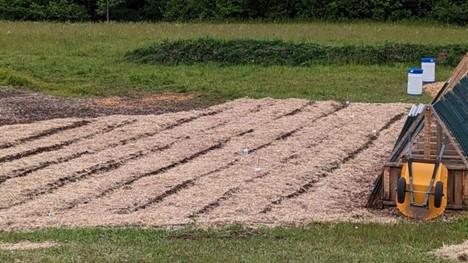Fall is a great time to condition the earth. That is because the soil has worked hard helping plants grow all spring and summer and may be depleted of nutrients come fall. Whether you are amending a vegetable garden, flower bed or lawn, the techniques that follow will help make your landscape more resilient in the seasons to come. Here are some tips and strategies that will help:
Creating and Using Leaf Mold
The model for amending soil is derived from how nature works. Leaves dropped during autumn accumulate on the forest floor to be broken down by microbes (generally saprophytic fungi). Over time, a very biologically active organic surface layer builds up. A similar process occurs in turf, except the breakdown of biomass is facilitated primarily by bacteria and actinomycetes.
Rather than bagging fallen leaves, compost them for a rich source of leaf mold. Fallen leaves are high in carbon and relatively low in nitrogen, so the breakdown is inherently slow. To speed things up, run a mulching mower over the fallen leaves to create a greater surface area for the microbes to go to work – or use a shredder. If the leaves are dry, spray them down to reduce dust and provide the fungi with adequate moisture.
Leaf mold works best in beds that you work regularly, such as vegetable and flower beds. Use the leaf mold much like you use a standard mulch. After planting, add a one-to-two-inch layer of leaf mold over the entire planting bed. The mulched layer will both reduce water loss and cool the soil.


Understanding And Making Compost
Leaf mold is qualitatively different from compost. It provides organic matter to the soil but doesn’t provide much in the way of nutrients. For that, you will need to amend your soil with compost.
You can make compost at home with two different techniques. The first involves adding the compostable materials, such as weeds, leaves, lawn clippings, and kitchen scraps, directly into the bed. Generally, you create a furrow, add the raw materials, cover over, and if dry, water in. The second is more involved but yields a larger amount of compost. Create a wire bin, about 3 feet in diameter and 4 feet high. Add in your organic materials and put garden soil between layers to inoculate the decomposition process.
Composting is an aerobic process, so you may want to build the pile around a central PVC pipe with holes drilled through at intervals to facilitate air flow. If you make a lot of compost, you may consider building a windrow, which is an elongated compost pile.
More Information About Composting
When the compost is fully decomposed to humus, add a 1–2-inch layer as a top dressing to new and established plantings. There is no need to turn it into the soil, unless you are adding it to the bed prior to seeding. If that is the case, then shallow till (harrow) to create the seed bed. Avoid deep tilling, since that will bring up buried weed seeds, creating a lot more maintenance come summer.
Mushroom compost is also a good option. It generally has a carbon-to-nitrogen ratio close to what microbes need to thrive and will retain its nutrient value over time, unlike manure.
Depending on the type of planting and slope of the land, you may choose to use woodchips, wheat straw or pine straw. The straws are stable on sloping grades. Use woodchips on ground that is relatively level or has a minimal slope. The choice of using woodchips over bark chips has to do with composition. Woodchips are composed of cellulose and lignin that break down into organic matter. Bark chips, on the other hand are comprised of suberin, or cork, which does not easily decompose. Woodchips are biologically active, whereas bark chips are inert and will not improve soil health.

There are numerous benefits to using compost on your landscape. Composts enrich the earth and support beneficial soil microbes. Fungal microbes (mycorrhizae) mine the soil for essential nutrients such as phosphorous, and supply these to associated plants. Free living soil bacteria and nodule forming bacteria (rhizobia) fix nitrogen from the atmosphere or convert it to usable and absorbable forms (nitrate, ammonium) for plant growth.
Fall is the ideal time to add amendments to soil. By replenishing your soil’s nutrients in fall, you’ll be setting your landscape up for a strong start in spring.


